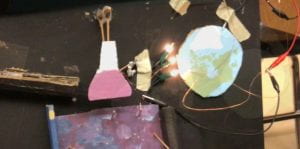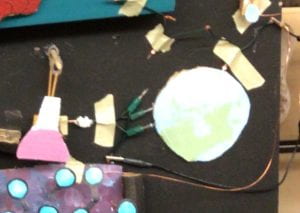Destination Imagination is a tournament using your team’s skills and abilities in science, technical, fine arts and improv. In this blog post I will summarize my team’s process of creating our DI challenge and I will also talk about my growth as a learner.
I was put into a group of 5 (Fraser, Zach, Cale, Sabrina) and assigned the  Scientific challenge. During our Maker class we started organizing and preparing for the tournament. There were lots of parts to the challenge but the main idea is that characters travel into a microworld and at least one of those characters encounter a mysterious object. We also had to include a technical method, 3D microworld scenery, microscopic imaging technique and two team choice elements. For our story, we decided to write a plot where three scientists and Uncle Frank accidentally travel into a bacterial cell. When in the cell, they find a mysterious object that they think is useless. They also interact with 3D scenery including some ribosomes which we represented through balloons. In trying to find a way out the scientists find that the wall of the cell is covered with fluorescents which they can see with a black light flashlight. Later when Uncle Frank trips on the mysterious object, again, he picks it up and presses two buttons.
Scientific challenge. During our Maker class we started organizing and preparing for the tournament. There were lots of parts to the challenge but the main idea is that characters travel into a microworld and at least one of those characters encounter a mysterious object. We also had to include a technical method, 3D microworld scenery, microscopic imaging technique and two team choice elements. For our story, we decided to write a plot where three scientists and Uncle Frank accidentally travel into a bacterial cell. When in the cell, they find a mysterious object that they think is useless. They also interact with 3D scenery including some ribosomes which we represented through balloons. In trying to find a way out the scientists find that the wall of the cell is covered with fluorescents which they can see with a black light flashlight. Later when Uncle Frank trips on the mysterious object, again, he picks it up and presses two buttons.  These buttons used hydraulics, our technical method, to open the box. Inside the box there were other parts of the cell tagged with fluorescents and when the characters touched that they were transported back to the lab. During our story, we also displayed two team choice elements. The first one was musical. Zach created music on an app on his iPad which we used when Uncle Frank enters the lab. The second team choice element was a poem
These buttons used hydraulics, our technical method, to open the box. Inside the box there were other parts of the cell tagged with fluorescents and when the characters touched that they were transported back to the lab. During our story, we also displayed two team choice elements. The first one was musical. Zach created music on an app on his iPad which we used when Uncle Frank enters the lab. The second team choice element was a poem  written by Fraser and myself which was read by Uncle Frank. It showed the idea that he thought very highly of himself which was a funny part of the performance. It took a long time to plan everything out and make it. My favourite part of the project was when we actually got to create the items and I did not enjoy the planning as much. We designed the microworld scenery, the mysterious object and all the items in the lab. Mostly we used cardboard to construct these items but we also used balloons, glow in the dark paint and hydraulics. The rest of our set used items from home and our costumes involved lab coats and a cowboy hat and plaid for Uncle Frank.
written by Fraser and myself which was read by Uncle Frank. It showed the idea that he thought very highly of himself which was a funny part of the performance. It took a long time to plan everything out and make it. My favourite part of the project was when we actually got to create the items and I did not enjoy the planning as much. We designed the microworld scenery, the mysterious object and all the items in the lab. Mostly we used cardboard to construct these items but we also used balloons, glow in the dark paint and hydraulics. The rest of our set used items from home and our costumes involved lab coats and a cowboy hat and plaid for Uncle Frank.
 I showed the most growth in my collaborative and personal social skills. The collaborating part was challenging with communicating with my team and setting up time to get work done. Some of my team members did not show up for the morning and after school practices we had decided on doing. When we started building our sets we communicated better and work together in a more collaborative way. For personal and social skills I improved on speaking up when team mates did not come to the decided on meetings. Since, we didn’t have much time before the tournament and one of our team members had to drop out of the performance, our meetings were very important. In the end, I was happy with the way our project came together and with our performance at the tournament. We got third in our age group in our challenge.
I showed the most growth in my collaborative and personal social skills. The collaborating part was challenging with communicating with my team and setting up time to get work done. Some of my team members did not show up for the morning and after school practices we had decided on doing. When we started building our sets we communicated better and work together in a more collaborative way. For personal and social skills I improved on speaking up when team mates did not come to the decided on meetings. Since, we didn’t have much time before the tournament and one of our team members had to drop out of the performance, our meetings were very important. In the end, I was happy with the way our project came together and with our performance at the tournament. We got third in our age group in our challenge.
Another thing we did well was adding humour and puns to our performance  because we wanted it to be interesting and the appraisers were fans of puns. The pun were did at the beginning of the performance when the asked if we were ready was: “We have our ions on the prize!” At the beginning of DI this year, I did not have an open mind and I was not certain I would enjoy it since last year was all on video. Although there times when I did not LOVE the project, I did have a lot of fun and am happy with our end result.
because we wanted it to be interesting and the appraisers were fans of puns. The pun were did at the beginning of the performance when the asked if we were ready was: “We have our ions on the prize!” At the beginning of DI this year, I did not have an open mind and I was not certain I would enjoy it since last year was all on video. Although there times when I did not LOVE the project, I did have a lot of fun and am happy with our end result.



 circuits. We also did an experiment on parallel and series circuits. Before we could do the experiment we needed to test the voltage and current in a
circuits. We also did an experiment on parallel and series circuits. Before we could do the experiment we needed to test the voltage and current in a 
 a lot of trouble getting the machine to work. We especially had trouble with the questioning step where we had a cup move down with the added weight of a marble. In the end we did get everything to work and we did show all 6 steps of the scientific method. We then took a video with voiceovers to show our machine.
a lot of trouble getting the machine to work. We especially had trouble with the questioning step where we had a cup move down with the added weight of a marble. In the end we did get everything to work and we did show all 6 steps of the scientific method. We then took a video with voiceovers to show our machine. time efficiently and went to lac during class time to work on workbooks without distractions. I also showed this competency when my group fell behind on our machine and came in during flex time to try to finish building the circuits part of the metaphor machine.
time efficiently and went to lac during class time to work on workbooks without distractions. I also showed this competency when my group fell behind on our machine and came in during flex time to try to finish building the circuits part of the metaphor machine. I showed how I accomplished this competency in the math test, individual blueprints and in the final blueprint. The math test took me long but i did get to understand how draw things The final blueprint has a grid scale, all lines are easy to see, and it is complete and accurate.
I showed how I accomplished this competency in the math test, individual blueprints and in the final blueprint. The math test took me long but i did get to understand how draw things The final blueprint has a grid scale, all lines are easy to see, and it is complete and accurate. I think my team and I did a good job one this curricular y competency. We hand built all the machine parts including the circuits. We included in our machine both a working parallel and series circuit that were turned on at different times. We included our circuit diagrams in our final blueprint.
I think my team and I did a good job one this curricular y competency. We hand built all the machine parts including the circuits. We included in our machine both a working parallel and series circuit that were turned on at different times. We included our circuit diagrams in our final blueprint.